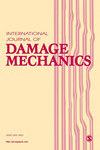A new damage-based failure criterion for nonlinear behavior of fibrous composite materials
IF 4
2区 工程技术
Q2 MATERIALS SCIENCE, MULTIDISCIPLINARY
引用次数: 0
Abstract
In the present paper, a novel combined damage-based failure criterion is being proposed for predicting failure stresses in unidirectional fibrous composite laminas or laminates having a nonlinear material behavior. The present model incorporates the effect of a quantitative damage factor on the final stresses at failure. This is achieved through a new term called the quantitative directional damage-index (QDD-I) which assesses the contribution and effectiveness of damage in each principal material direction on the present failure criterion. From the QDD-I, it is proved that the principal material-direction with a linear or nonlinear stress-strain behavior showed a quantitative damage response on the proposed failure criterion. In a composite lamina, the contribution of fiber-damage and matrix transverse-damage are proved to have minor effects on the failure criterion, while in-plane shear-damage has the major effect. In order to verify the suitability and applicability of the criterion, results are tested using various theoretical and experimental data available from the literature. Furthermore, the model is compared with other failure criteria under both uniaxial and biaxial loading cases from a worldwide comparison, which showed reasonable accuracy and good agreement. Three types of fibrous composite materials are used; Graphite/Epoxy 4617/Modmore-II, Carbon/Epoxy AS4/3501-6, and Boron/Epoxy Narmco 5505.一种新的基于损伤的纤维复合材料非线性失效准则
本文提出了一种新的基于损伤的组合失效准则,用于预测具有非线性材料行为的单向纤维复合材料层压板或层压板的失效应力。本模型结合了定量损伤因子对失效时最终应力的影响。这是通过一个称为定量方向损伤指数(QDD-I)的新术语实现的,该指数评估了每个主要材料方向上损伤对当前失效标准的贡献和有效性。根据QDD-I,证明了具有线性或非线性应力-应变行为的主材料方向在所提出的失效准则上表现出定量的损伤响应。在复合材料层板中,纤维损伤和基体横向损伤对失效准则的影响较小,而面内剪切损伤的影响较大。为了验证该标准的适用性和适用性,使用文献中的各种理论和实验数据对结果进行了测试。此外,将该模型与世界范围内的单轴和双轴载荷下的其他失效准则进行了比较,结果表明该模型具有合理的精度和良好的一致性。使用了三种类型的纤维复合材料;石墨/环氧树脂4617/Modmore II、碳/环氧树脂AS4/3501-6和硼/环氧树脂Narmco 5505。
本文章由计算机程序翻译,如有差异,请以英文原文为准。
求助全文
约1分钟内获得全文
求助全文
来源期刊

International Journal of Damage Mechanics
工程技术-材料科学:综合
CiteScore
8.70
自引率
26.20%
发文量
48
审稿时长
5.4 months
期刊介绍:
Featuring original, peer-reviewed papers by leading specialists from around the world, the International Journal of Damage Mechanics covers new developments in the science and engineering of fracture and damage mechanics.
Devoted to the prompt publication of original papers reporting the results of experimental or theoretical work on any aspect of research in the mechanics of fracture and damage assessment, the journal provides an effective mechanism to disseminate information not only within the research community but also between the reseach laboratory and industrial design department.
The journal also promotes and contributes to development of the concept of damage mechanics. This journal is a member of the Committee on Publication Ethics (COPE).
 求助内容:
求助内容: 应助结果提醒方式:
应助结果提醒方式:


